A Win–Win Situation: Performance and Adaptability of Petite Sweetpotato Production in a Temperate Region
Abstract
:1. Introduction
2. Materials and Methods
2.1. Field Preparation
2.2. Harvesting
2.3. Manual Sorting, Curing, Storage and Data Collection
2.4. Growing Degree Days (GGD)
2.5. Statistical Analysis
3. Results
4. Discussion
Supplementary Materials
Author Contributions
Funding
Institutional Review Board Statement
Informed Consent Statement
Data Availability Statement
Acknowledgments
Conflicts of Interest
References
- USDA National Agricultural Statistics Service. Available online: https://data.nal.usda.gov/dataset/nass-quick-stats (accessed on 6 July 2020).
- Duque, L.O. Performance of Sweetpotato Varieties Grown Using Black Plastic Mulch in Pennsylvania. Horttechnology 2020, 30, 797–802. [Google Scholar] [CrossRef]
- Truong, V.D.; Avula, R.Y.; Pecota, K.V.; Yencho, G.C. Sweetpotato Production, Processing, and Nutritional Quality. In Handbook of Vegetables and Vegetable Processing; John Wiley and sons Ltd.: New York, NY, USA, 2018; pp. 811–838. [Google Scholar]
- USDA. United States Standards for Grades of Sweetpotatoes Agricultural Marketing Service/Fruit and Vegetable Division. Available online: https://www.ams.usda.gov/sites/default/files/media/Sweetpotato_Standard%5B1%5D.pdf (accessed on 6 July 2020).
- Hoffman, M. Fingerling Sweetpotatoes Are the Next “It” Vegetable and We Are Fully on Board. Available online: https://www.epicurious.com/ingredients/what-are-fingerling-sweet-potatoes-how-to-cook-them-article (accessed on 10 June 2021).
- Northeast Regional Climate Center. Available online: http://www.nrcc.cornell.edu/ (accessed on 10 July 2020).
- Estimating Soil Moisture by Feel and Appearance. Available online: https://www.nrcs.usda.gov/Internet/FSE_DOCUMENTS/nrcs144p2_051845.pdf (accessed on 6 August 2020).
- OMAFRA. Vegetable Production Recommendations 2010–2011; Publication 363; Ontario Ministry of Agriculture, Food and Rural Affairs: Guelph, ON, Canada, 2010.
- Jansson, R.K.; Raman, K.V. Sweetpotato pest management: A global overview. In Sweetpotato Pest Management, A Global Perspective; CRC Press: Boca Raton, FL, USA, 1991; pp. 1–12. [Google Scholar]
- Bouwkamp, J.C. Introduction—Part I. In Sweetpotato Products; Bouwkamp, J.C., Ed.; CRC Press: Boca Raton, FL, USA, 1985; pp. 11–16. [Google Scholar]
- Wees, D.; Seguin, P.; Boisclair, J. Sweetpotato production in a short-season area utilizing black plastic mulch: Effects of cultivar, in-row plant spacing, and harvest date on yield parameters. Can. J. Plant Sci. 2016, 96, 139–147. [Google Scholar] [CrossRef] [Green Version]
- Wees, D.; Seguin, P.; Boisclair, J.; Gendre, C. Performance and Quality of Sweetpotato Cultivars Grown in Quebec, Canada with Biodegradable Plastic Mulch. Horttechnology 2015, 25, 815. [Google Scholar] [CrossRef] [Green Version]
- Hochmuth, G.J.; Howell, J.C., Jr. Effect of black plastic mulch and raised beds on sweetpotato growth and root yield in a northern region. HortScience 1983, 18, 467–468. [Google Scholar]
- Sideman, R.G. Performance of Sweetpotato Cultivars Grown Using Biodegradable Black Plastic Mulch in New Hampshire. Horttechnology 2015, 25, 412–416. [Google Scholar] [CrossRef] [Green Version]
- Nair, A.; Bergaum, B.; Bilenky, M. Sweetpotato Cultivar Trial. Available online: http://farms.ag.iastate.edu/sites/default/files/SweetPotatoCultivar.pdf (accessed on 6 July 2020).
- Goldy, R.; Wendzel, V. Evaluation of Ten Sweetpotato Cultivars in Southwest Michigan. Available online: https://extension.umd.edu/sites/extension.umd.edu/files/_docs/programs/mdvegetables/MidwestVegTrialReport_2008.pdf (accessed on 6 July 2020).
- Bornt, C. Improving the Yield and Quality of Sweetpotatoes Grown in New York, 2012 Final Report. Available online: https://projects.sare.org/project-reports/lne10-292/ (accessed on 6 July 2020).
- Schultheis, J.R.; Walters, S.A.; Adams, D.E.; Estes, E.A. In-row Plant Spacing and Date of Harvest of ‘Beauregard’ Sweetpotato Affect Yield and Return on Investment. HortScience 1999, 34, 1229. [Google Scholar] [CrossRef] [Green Version]
- Arancibia, R.A.; Smith, C.D.; LaBonte, D.R.; Main, J.L.; Smith, T.P.; Villordon, A.Q. Optimizing Sweetpotato Production for Fresh and Processing Markets through Plant Spacing and Planting-harvest Time. Horttechnology 2014, 24, 16–24. [Google Scholar] [CrossRef] [Green Version]
- Smith, T.P.; Stoddard, S.; Shankle, M.; Schultheis, J. Sweetpotato Production in the United States. In The Sweetpotato; Loebenstein, G., Thottappilly, G., Eds.; Springer: Dordrecht, The Netherlands, 2009; pp. 287–323. [Google Scholar]
- Villordon, A.; Clark, C.; Ferrin, D.; LaBonte, D. Using Growing Degree Days, Agrometeorological Variables, Linear Regression, and Data Mining Methods to Help Improve Prediction of Sweetpotato Harvest Date in Louisiana. Horttechnology 2009, 19, 133. [Google Scholar] [CrossRef] [Green Version]
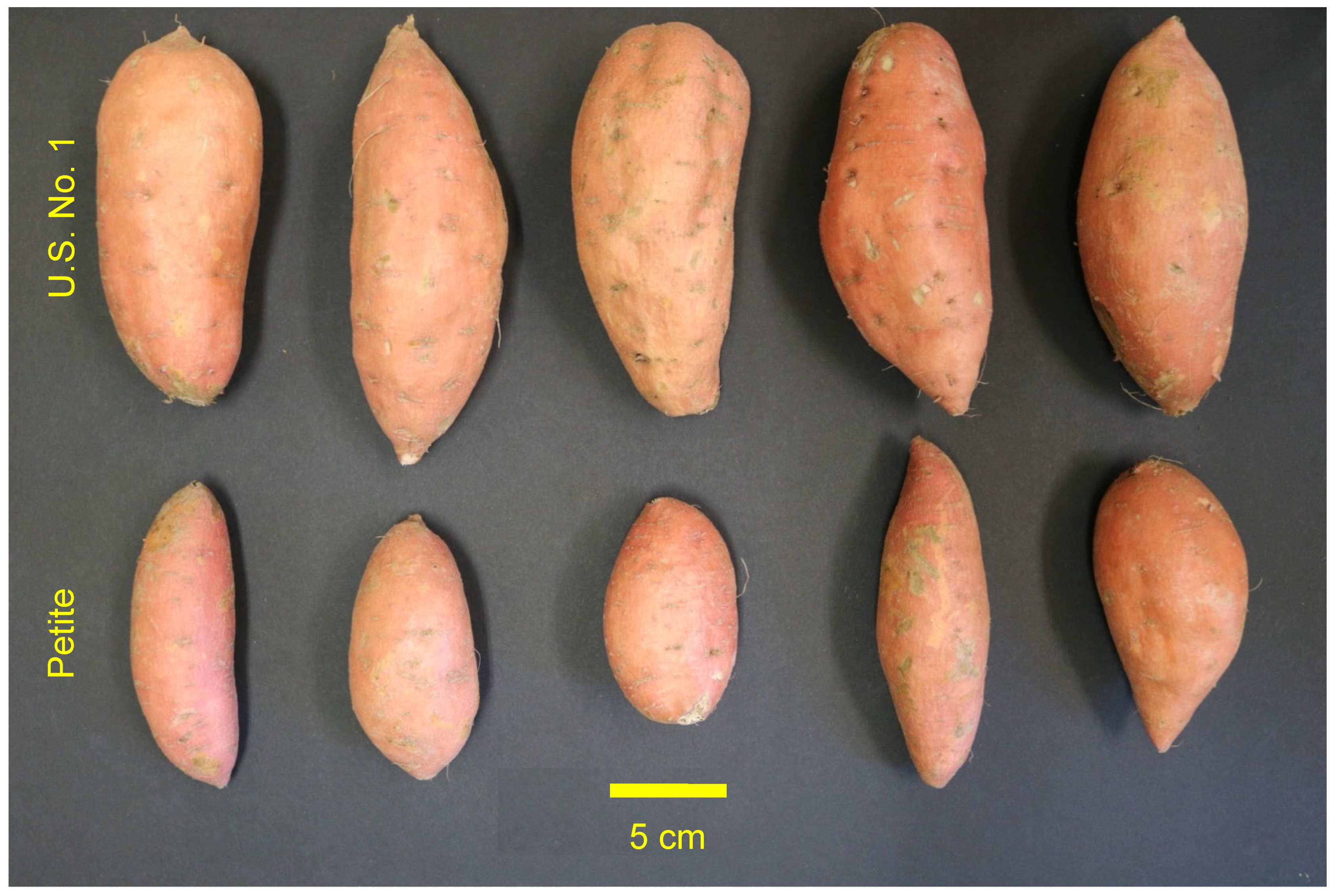

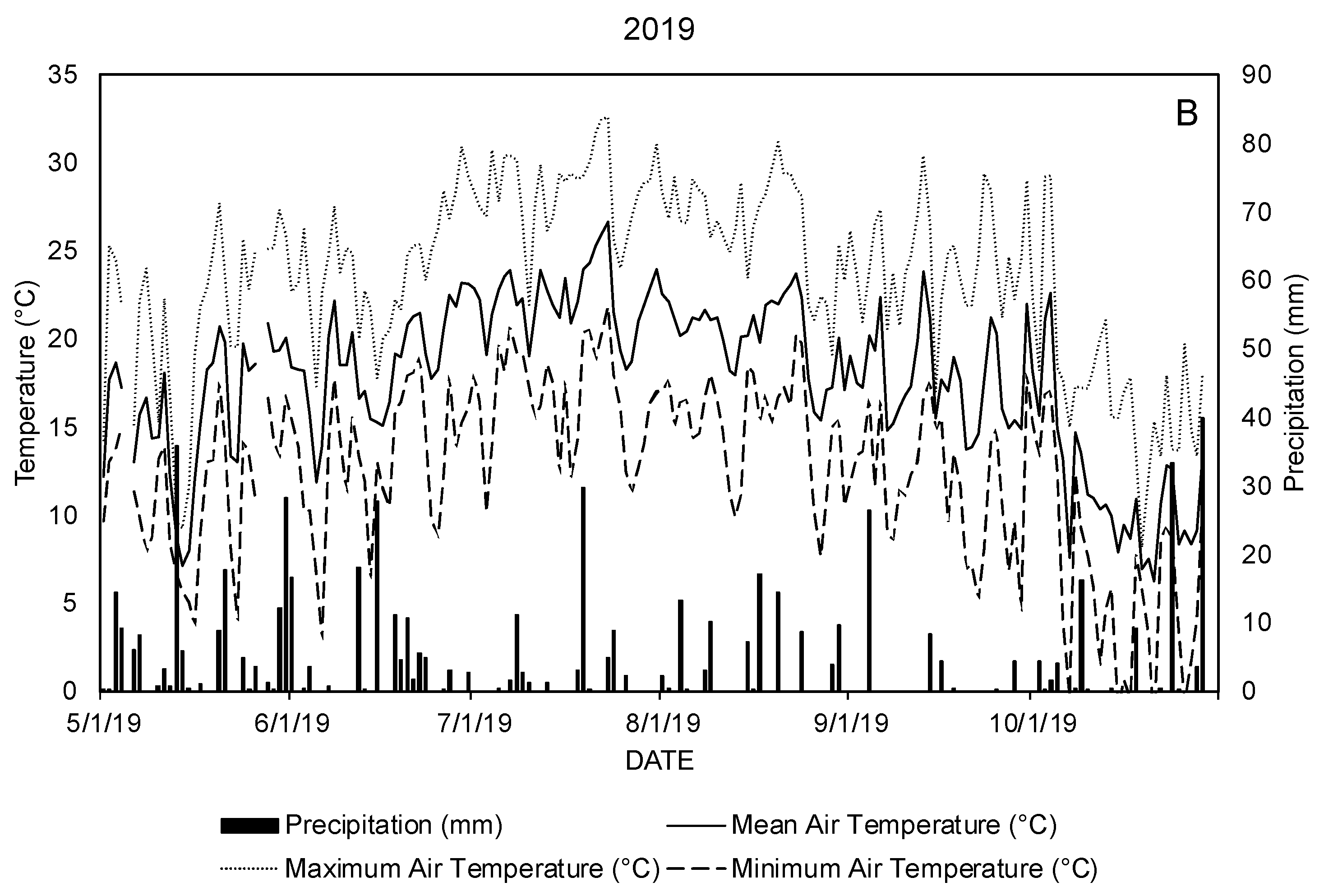
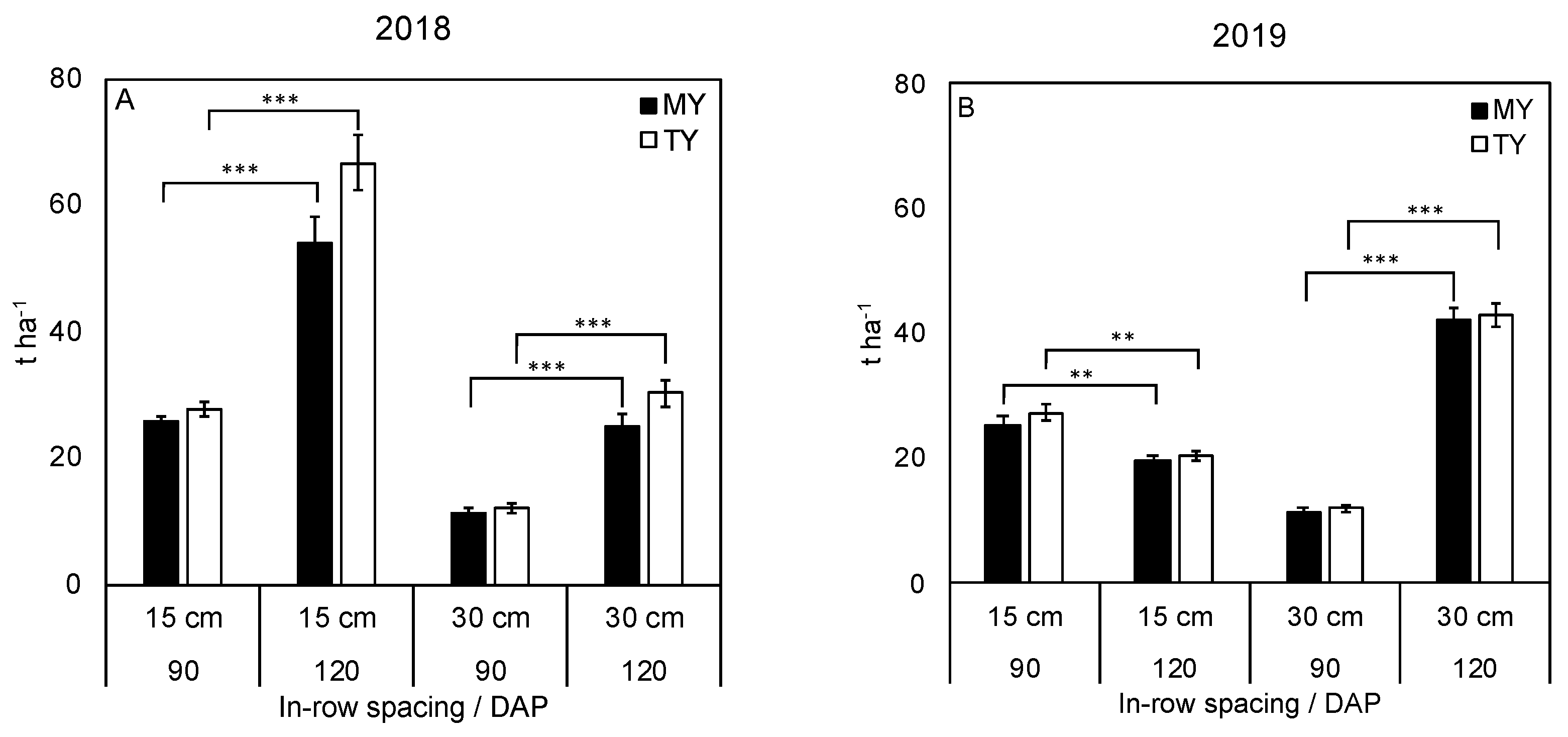
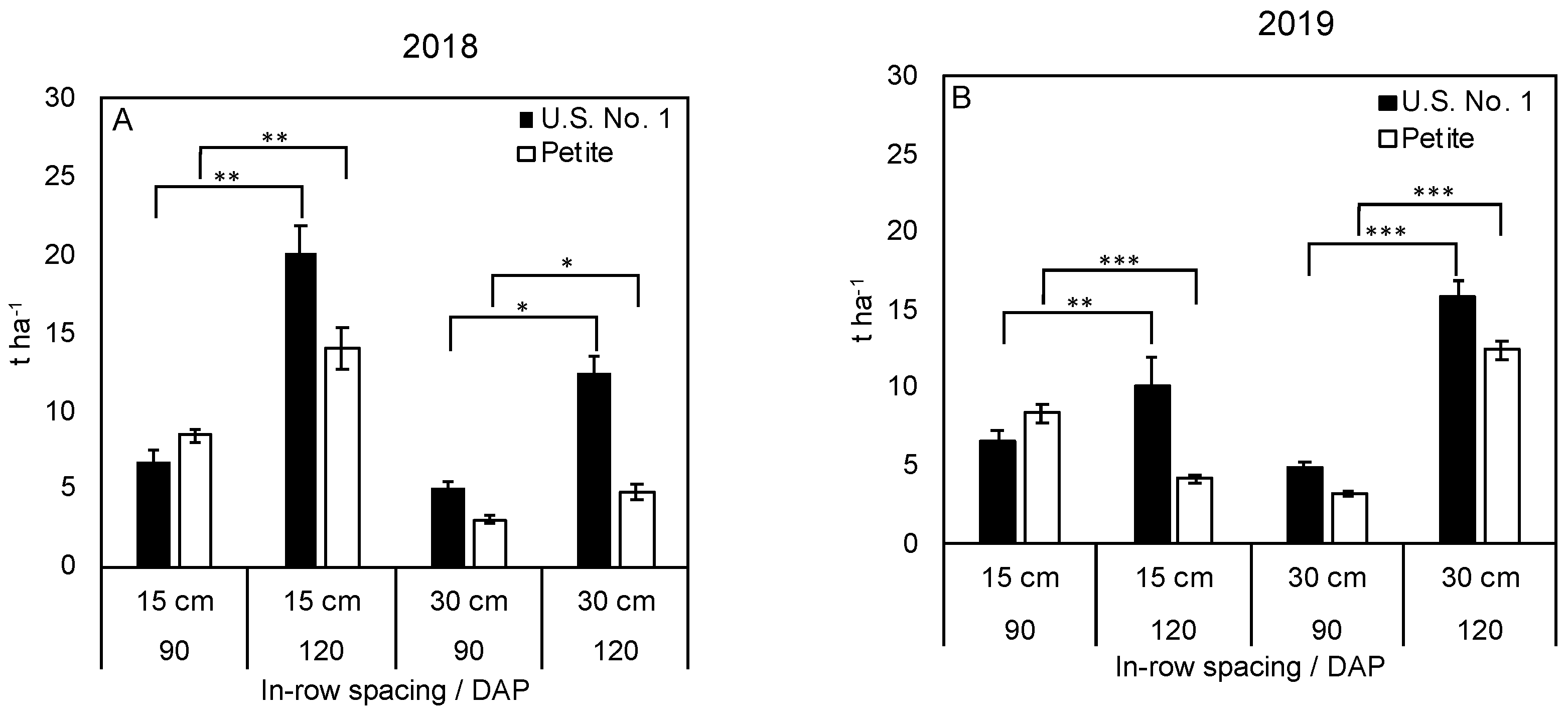
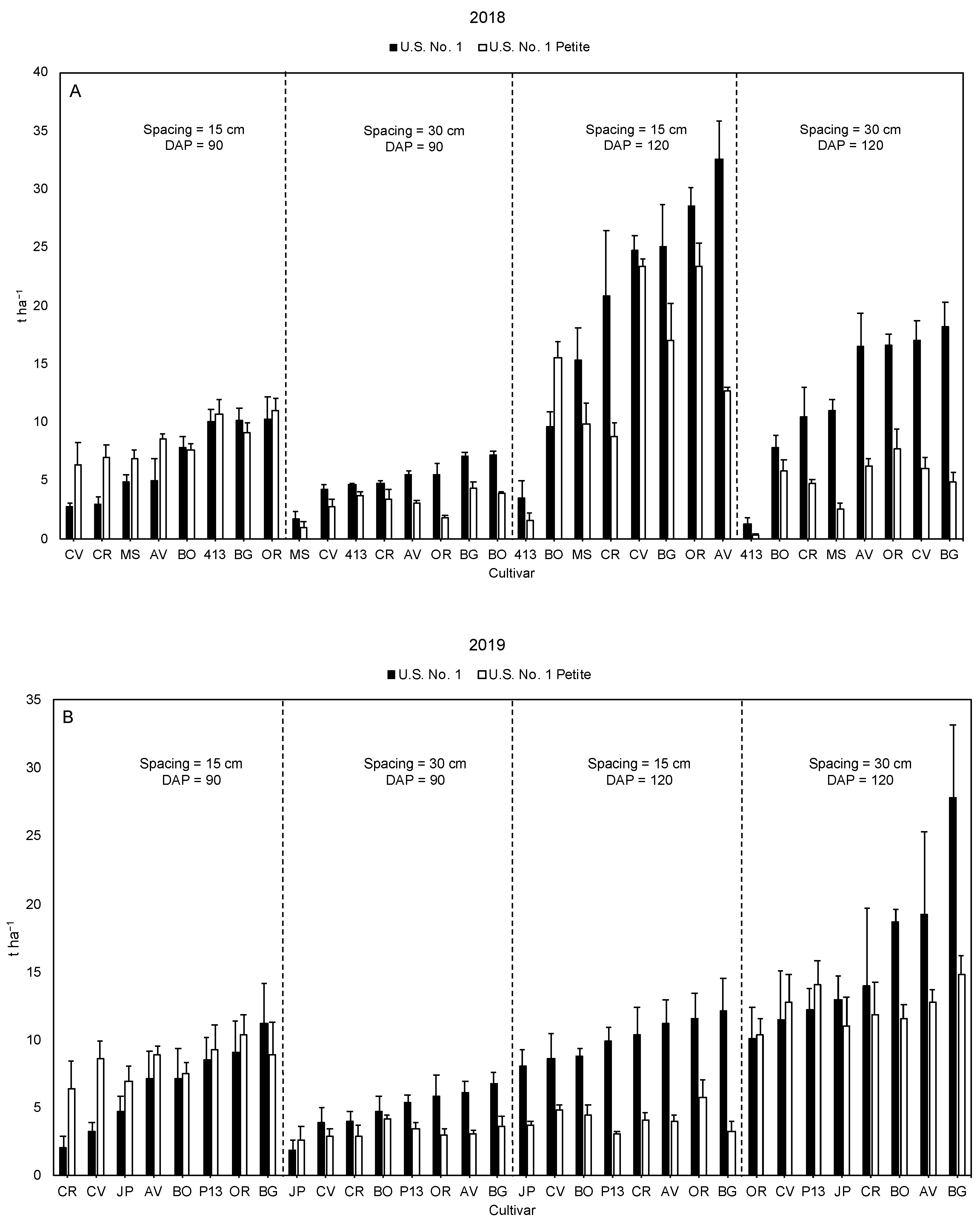
| Growing Degree-Days (GDD) | |||||||
|---|---|---|---|---|---|---|---|
| Base 10 °C | Base 15.5 °C | ||||||
| Year | Harvest Date | DAP | Actual DAP | Cumulative GDD | Increase in GDD | Cumulative GDD | Increase in GDD |
| 2018 | 2 September | 90 | 97 | 1096.0 | - | 628.3 | - |
| 3 October | 120 | 128 | 1393.5 | 297.5 | 783.6 | 155.3 | |
| 2019 | 3 September | 90 | 93 | 999.3 | - | 558.3 | - |
| 1 October | 120 | 124 | 1251.7 | 252.4 | 691 | 132.7 | |
| Sources | 2018 | 2019 | ||||||||||
|---|---|---|---|---|---|---|---|---|---|---|---|---|
| TY (t ha−1) | MY (t ha−1) | TY (t ha−1) | MY (t ha−1) | |||||||||
| df | F-Ratio | p-Value | df | F-Ratio | p-Value | df | F-Ratio | p-Value | df | F-Ratio | p-Value | |
| Cultivar | 7 | 37.3 | <0.0001 | 7 | 37.1 | <0.0001 | 7 | 2.9 | 0.0095 | 7 | 2.8 | 0.0098 |
| DAP | 1 | 751.1 | <0.0001 | 1 | 485.9 | <0.0001 | 1 | 104.1 | 0.0001 | 1 | 109.0 | <0.0001 |
| In-row spacing | 1 | 628.0 | <0.0001 | 1 | 510.1 | <0.0001 | 1 | 9.6 | 0.0025 | 1 | 13.0 | 0.0005 |
| Cultivar × DAP | 7 | 39.6 | <0.0001 | 7 | 41.8 | <0.0001 | 7 | 0.5 | 0.814 | 7 | 0.6 | 0.7274 |
| Cultivar × In-row spacing | 7 | 3.9 | 0.0008 | 7 | 3.9 | 0.0008 | 7 | 1.5 | 0.1825 | 7 | 1.7 | 0.1223 |
| DAP × In-row spacing | 1 | 99.7 | <0.0001 | 1 | 58.9 | <0.0001 | 1 | 259.3 | 0.0001 | 1 | 230.4 | <0.0001 |
| Cultivar × DAP × In-row spacing | 7 | 8.1 | <0.0001 | 7 | 8.2 | <0.0001 | 7 | 1.5 | 0.1926 | 7 | 1.4 | 0.2123 |
| Year | Variety | DAP | In-Row Spacing (cm) | U.S. No. 1 (t ha−1) | Petite (t ha−1) | Jumbo (t ha−1) | Canner (t ha−1) | Cull (t ha−1) | TY (t ha−1) | MY (t ha−1) | |||||||
|---|---|---|---|---|---|---|---|---|---|---|---|---|---|---|---|---|---|
| 2018 | AV | 90 | 15 | 4.9 | H | 8.6 | DEFGHIJ | 0.0 | C | 10.6 | DEFG | 1.3 | EF | 25.4 | FGHIJK | 24.1 | DEFGHI |
| 90 | 30 | 5.4 | GH | 3.1 | HIJKLMN | 0.0 | C | 2.6 | JKL | 0.7 | EF | 11.8 | KLM | 11.1 | IJK | ||
| 120 | 15 | 32.6 | A | 12.7 | BCD | 9.3 | AB | 16.2 | CD | 20.6 | A | 91.3 | A | 70.7 | A | ||
| 120 | 30 | 16.5 | CDEF | 6.3 | EFGHIJKLMN | 4.3 | ABC | 3.1 | IJKL | 4.8 | EF | 35.0 | DEFGH | 30.2 | DEFG | ||
| BG | 90 | 15 | 10.1 | EFGH | 9.1 | DEFGH | 1.1 | BC | 7.8 | EFGHIJK | 2.5 | EF | 30.7 | DEFGHI | 28.2 | DEFGH | |
| 90 | 30 | 7.0 | FGH | 4.3 | GHIJKLMN | 2.0 | BC | 1.8 | KL | 0.5 | F | 15.7 | IJKLM | 15.2 | HIJK | ||
| 120 | 15 | 25.1 | ABC | 17.0 | B | 8.1 | ABC | 24.4 | AB | 18.3 | AB | 92.8 | A | 74.5 | A | ||
| 120 | 30 | 18.2 | CDE | 4.9 | EFGHIJKLMN | 11.7 | A | 4.2 | HIJKL | 7.0 | CDEF | 45.9 | CD | 38.9 | CD | ||
| BO | 90 | 15 | 7.8 | FGH | 7.6 | DEFGHIJKL | 0.0 | C | 14.1 | CDE | 2.1 | EF | 31.6 | DEFGHI | 29.5 | DEFGH | |
| 90 | 30 | 7.2 | FGH | 3.9 | GHIJKLMN | 0.0 | C | 4.9 | GHIJKL | 0.7 | EF | 16.7 | IJKLM | 16.0 | GHIJK | ||
| 120 | 15 | 9.6 | EFGH | 15.5 | BC | 0.4 | C | 25.1 | A | 3.7 | EF | 54.3 | C | 50.6 | BC | ||
| 120 | 30 | 7.9 | FGH | 5.8 | EFGHIJKLMN | 0.3 | C | 8.5 | EFGHIJ | 1.4 | EF | 23.8 | FGHIJKL | 22.4 | EFGHIJ | ||
| CR | 90 | 15 | 3.0 | H | 7.0 | DEFGHIJKLM | 1.1 | BC | 9.5 | EFGH | 4.2 | EF | 24.7 | FGHIJKL | 20.6 | FGHIJ | |
| 90 | 30 | 4.7 | H | 3.4 | HIJKLMN | 0.4 | C | 4.2 | HIJKL | 1.0 | EF | 13.6 | JKLM | 12.6 | IJK | ||
| 120 | 15 | 20.8 | BCD | 8.7 | DEFGHI | 8.3 | ABC | 16.9 | CD | 16.5 | ABC | 71.2 | B | 54.7 | B | ||
| 120 | 30 | 10.4 | EFGH | 4.7 | FGHIJKLMN | 2.4 | BC | 6.3 | FGHIJKL | 4.4 | EF | 28.2 | EFGHIJ | 23.8 | EFGHI | ||
| CV | 90 | 15 | 2.7 | H | 6.3 | EFGHIJKLMN | 0.0 | C | 11.9 | DEF | 1.8 | EF | 22.8 | GHIJKL | 21.0 | EFGHIJ | |
| 90 | 30 | 4.2 | H | 2.8 | IJKLMN | 0.3 | C | 1.4 | L | 0.3 | F | 9.0 | LM | 8.7 | JK | ||
| 120 | 15 | 24.7 | ABC | 23.4 | A | 8.3 | ABC | 18.4 | BC | 10.5 | BCDE | 85.3 | AB | 74.8 | A | ||
| 120 | 30 | 17.0 | CDEF | 6.0 | EFGHIJKLMN | 3.4 | ABC | 4.9 | GHIJKL | 8.3 | CDEF | 39.7 | CDEF | 31.4 | DEF | ||
| MS | 90 | 15 | 4.9 | H | 6.9 | DEFGHIJKLM | 2.5 | BC | 7.8 | FGHIJK | 1.0 | EF | 23.0 | GHIJKL | 22.0 | EFGHIJ | |
| 90 | 30 | 1.7 | H | 1.0 | MN | 0.3 | C | 1.4 | L | 0.6 | F | 4.9 | M | 4.4 | K | ||
| 120 | 15 | 15.3 | CDEFG | 9.8 | CDEFG | 4.0 | ABC | 6.8 | FGHIJKL | 8.2 | CDEF | 44.0 | CDE | 35.8 | CDE | ||
| 120 | 30 | 11.0 | DEFGH | 2.5 | JKLMN | 2.6 | BC | 1.7 | KL | 1.4 | EF | 19.2 | HIJKLM | 17.8 | FGHIJK | ||
| 413 | 90 | 15 | 10.1 | EFGH | 10.7 | CDEF | 1.3 | BC | 9.5 | EFGH | 1.8 | EF | 33.4 | DEFGH | 31.6 | DEF | |
| 90 | 30 | 4.6 | H | 3.7 | GHIJKLMN | 0.7 | BC | 3.4 | HIJKL | 0.0 | F | 12.5 | JKLM | 12.5 | IJK | ||
| 120 | 15 | 3.5 | H | 1.5 | LMN | 2.5 | BC | 0.8 | L | 14.9 | ABCD | 23.3 | GHIJKL | 8.4 | JK | ||
| 120 | 30 | 1.3 | H | 0.3 | N | 1.5 | BC | 1.4 | L | 6.4 | DEF | 11.0 | KLM | 4.5 | K | ||
| OR | 90 | 15 | 10.2 | EFGH | 11.0 | BCDE | 1.4 | BC | 5.5 | GHIJKL | 1.9 | EF | 30.0 | DEFGHI | 28.1 | DEFGH | |
| 90 | 30 | 5.5 | GH | 1.8 | KLMN | 0.4 | C | 3.2 | HIJKL | 0.9 | EF | 11.8 | KLM | 10.9 | IJK | ||
| 120 | 15 | 28.5 | AB | 23.3 | A | 1.2 | BC | 9.3 | EFGHI | 8.4 | CDEF | 70.8 | B | 62.4 | AB | ||
| 120 | 30 | 16.6 | CDEF | 7.7 | DEFGHIJK | 4.2 | ABC | 3.5 | HIJKL | 6.3 | DEF | 38.2 | CDEFG | 31.9 | DEF | ||
| p > F | 0.0054 | 0.0001 | 0.2604 | 0.0001 | 0.0608 | 0.0001 | 0.0001 | ||||||||||
| 2019 | AV | 90 | 15 | 7.1 | BCD | 8.9 | ABCDEFG | 0.0 | A | 10.2 | BCDEFG | 2.2 | AB | 28.3 | CDEFGH | 26.1 | DEFGH |
| 90 | 30 | 6.1 | BCD | 3.1 | G | 0.0 | A | 2.8 | HIJ | 0.6 | B | 12.5 | GHIJ | 12.0 | GHI | ||
| 120 | 15 | 11.2 | BCD | 3.9 | FG | 0.9 | A | 3.2 | GHIJ | 0.6 | B | 19.7 | FGHIJ | 19.2 | EFGHI | ||
| 120 | 30 | 19.2 | AB | 12.7 | ABC | 1.0 | A | 13.4 | ABCD | 0.0 | B | 46.4 | ABC | 46.4 | ABC | ||
| BG | 90 | 15 | 11.1 | BCD | 8.9 | ABCDEFG | 0.7 | A | 7.2 | CDEFGHIJ | 2.6 | AB | 30.5 | CDEFG | 28.0 | CDEFG | |
| 90 | 30 | 6.8 | BCD | 3.6 | G | 0.9 | A | 1.8 | J | 0.8 | B | 13.9 | GHIJ | 13.1 | GHI | ||
| 120 | 15 | 12.1 | BCD | 3.2 | G | 1.8 | A | 1.8 | J | 0.9 | B | 19.8 | FGHIJ | 19.0 | EFGHI | ||
| 120 | 30 | 27.9 | A | 14.8 | A | 0.6 | A | 9.3 | BCDEFGHI | 0.5 | B | 53.0 | A | 52.5 | A | ||
| BO | 90 | 15 | 7.1 | BCD | 7.5 | BCDEFG | 0.0 | A | 13.1 | ABCDE | 1.6 | AB | 29.4 | CDEFGH | 27.7 | DEFGH | |
| 90 | 30 | 4.7 | D | 4.2 | FG | 0.0 | A | 5.3 | FGHIJ | 0.5 | B | 14.7 | GHIJ | 14.2 | FGHI | ||
| 120 | 15 | 8.8 | BCD | 4.5 | EFG | 0.5 | A | 6.2 | EFGHIJ | 0.7 | B | 20.6 | FGHIJ | 19.9 | EFGHI | ||
| 120 | 30 | 18.7 | ABC | 11.5 | ABCD | 0.0 | A | 19.7 | A | 1.4 | AB | 51.3 | AB | 49.9 | AB | ||
| CR | 90 | 15 | 2.0 | D | 6.3 | CDEFG | 0.4 | A | 10.1 | BCDEFG | 4.1 | A | 22.9 | EFGHIJ | 18.8 | EFGHI | |
| 90 | 30 | 4.0 | D | 2.9 | G | 0.5 | A | 3.3 | GHIJ | 1.4 | AB | 12.0 | HIJ | 10.7 | GHI | ||
| 120 | 15 | 10.4 | BCD | 4.1 | FG | 0.3 | A | 3.8 | GHIJ | 2.3 | AB | 20.9 | FGHIJ | 18.6 | EFGHI | ||
| 120 | 30 | 13.9 | BCD | 11.8 | ABCD | 0.4 | A | 15.0 | AB | 1.2 | B | 42.3 | ABCD | 41.1 | ABCD | ||
| CV | 90 | 15 | 3.2 | D | 8.6 | ABCDEFG | 0.0 | A | 13.8 | ABC | 1.8 | AB | 27.5 | DEFGHI | 25.6 | DEFGH | |
| 90 | 30 | 3.9 | D | 2.9 | G | 0.2 | A | 2.3 | IJ | 0.6 | B | 9.8 | IJ | 9.2 | HI | ||
| 120 | 15 | 8.6 | BCD | 4.8 | EFG | 0.5 | A | 5.0 | FGHIJ | 0.0 | B | 18.9 | FGHIJ | 18.9 | EFGHI | ||
| 120 | 30 | 11.5 | BCD | 12.8 | ABC | 0.0 | A | 15.2 | AB | 0.8 | B | 40.2 | ABCDE | 39.5 | ABCD | ||
| JP | 90 | 15 | 4.7 | D | 6.9 | CDEFG | 1.5 | A | 6.7 | DEFGHIJ | 1.5 | AB | 21.4 | FGHIJ | 19.8 | EFGHI | |
| 90 | 30 | 1.9 | D | 2.6 | G | 0.3 | A | 1.9 | J | 0.4 | B | 7.2 | J | 6.8 | I | ||
| 120 | 15 | 8.0 | BCD | 3.7 | FG | 2.6 | A | 3.3 | GHIJ | 0.3 | B | 17.9 | FGHIJ | 17.7 | EFGHI | ||
| 120 | 30 | 13.0 | BCD | 11.0 | ABCDE | 1.2 | A | 9.4 | BCDEFGH | 1.4 | AB | 36.1 | ABCDEF | 34.6 | ABCDE | ||
| P13 | 90 | 15 | 8.5 | BCD | 9.2 | ABCDEFG | 0.6 | A | 9.3 | BCDEFGHI | 1.0 | B | 28.7 | CDEFGH | 27.7 | DEFGH | |
| 90 | 30 | 5.3 | D | 3.4 | G | 1.2 | A | 3.4 | GHIJ | 0.0 | B | 13.3 | GHIJ | 13.3 | FGHI | ||
| 120 | 15 | 9.9 | BCD | 3.1 | G | 1.9 | A | 4.6 | FGHIJ | 0.9 | B | 20.4 | FGHIJ | 19.5 | EFGHI | ||
| 120 | 30 | 12.2 | BCD | 14.0 | AB | 0.0 | A | 14.1 | ABC | 0.5 | B | 40.9 | ABCDE | 40.4 | ABCD | ||
| OR | 90 | 15 | 9.1 | BCD | 10.4 | ABCDEF | 0.9 | A | 7.8 | CDEFGHIJ | 1.5 | AB | 29.6 | CDEFGH | 28.1 | CDEFG | |
| 90 | 30 | 5.8 | CD | 2.9 | G | 0.3 | A | 3.0 | HIJ | 0.8 | B | 12.9 | GHIJ | 12.1 | GHI | ||
| 120 | 15 | 11.6 | BCD | 5.8 | DEFG | 2.2 | A | 4.3 | FGHIJ | 0.7 | B | 24.6 | DEFGHIJ | 23.9 | DEFGHI | ||
| 120 | 30 | 10.1 | BCD | 10.4 | ABCDEF | 0.0 | A | 11.4 | BCDEF | 1.2 | B | 33.0 | BCDEF | 31.8 | BCDEF | ||
| p > F | 0.1 | 0.41 | 0.84 | 0.02 | 0.96 | 0.19 | 0.2 | ||||||||||
Publisher’s Note: MDPI stays neutral with regard to jurisdictional claims in published maps and institutional affiliations. |
© 2022 by the authors. Licensee MDPI, Basel, Switzerland. This article is an open access article distributed under the terms and conditions of the Creative Commons Attribution (CC BY) license (https://creativecommons.org/licenses/by/4.0/).
Share and Cite
Duque, L.O.; Sánchez, E.; Pecota, K.; Yencho, C. A Win–Win Situation: Performance and Adaptability of Petite Sweetpotato Production in a Temperate Region. Horticulturae 2022, 8, 172. https://doi.org/10.3390/horticulturae8020172
Duque LO, Sánchez E, Pecota K, Yencho C. A Win–Win Situation: Performance and Adaptability of Petite Sweetpotato Production in a Temperate Region. Horticulturae. 2022; 8(2):172. https://doi.org/10.3390/horticulturae8020172
Chicago/Turabian StyleDuque, Luis O., Elsa Sánchez, Kenneth Pecota, and Craig Yencho. 2022. "A Win–Win Situation: Performance and Adaptability of Petite Sweetpotato Production in a Temperate Region" Horticulturae 8, no. 2: 172. https://doi.org/10.3390/horticulturae8020172
APA StyleDuque, L. O., Sánchez, E., Pecota, K., & Yencho, C. (2022). A Win–Win Situation: Performance and Adaptability of Petite Sweetpotato Production in a Temperate Region. Horticulturae, 8(2), 172. https://doi.org/10.3390/horticulturae8020172





